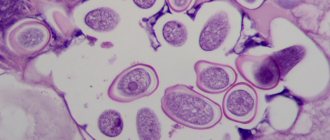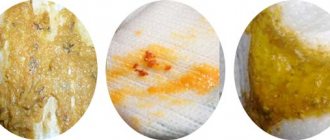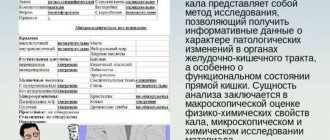/About children/Newborn. Child under one year old
One of the main problems of parents of babies is the child's stool. Parents always think that it is their child who is doing “this” in a completely different way than required, and they are ready to go through hundreds of studies in order to find non-existent problems. Two problems - constipation and diarrhea - are sometimes caused by parents themselves. However, absolutely normal “major results” of a child’s life activity are often considered a problem. To be able to distinguish normal stool from problematic stool, you need to know the norms. Let's talk about them.
What should normal stool look like in a newborn?
The first stool of a newborn baby has a very thick and viscous consistency, and a dark brown, almost black color. This is the feces that appear in a baby immediately after birth. It consists of waste products of the child during its intrauterine development. Original stool is called meconium. Meconium has no odor.
Already from the third day after birth, the baby's stool changes dramatically. It becomes more liquid and less viscous. There may still be remains of meconium in it. This is the so-called transitional feces. It is already much lighter than meconium, greenish-yellow. Transitional stool contains mucus and lumps.
After a week, the baby's stool gradually becomes mature. Its color turns golden yellow. This bright yellow color of feces is typical for babies who are exclusively breastfed. The consistency of mature feces is quite liquid, but homogeneous and mushy. The smell of a breastfed baby's feces is pleasantly sour, reminiscent of sour milk.
The baby can defecate up to eight times a day. This is normal for a newborn. Formula-fed babies have bowel movements less often. Their poop is not as yellow. They have a darker color, close to brown. The consistency of stool in artificial babies is thicker. The smell of feces is pungent and unpleasant. The feces of mixed-fed babies have the same characteristics. These are children who are fed both formula and breast milk. As children age, they defecate less frequently.
In a healthy child, stool may change. It may become more liquid or almost solid. The color of the stool may turn green. Such changes are quite normal. The characteristics of the stool depend on the type of foods the mother eats, the fat content of her milk, and the type of formula. Bowel movements may change if the child overeats.
The stool of babies who suck only foremilk becomes more liquid. This is the first milk that comes from the breast. It contains more water. If the mother does not completely empty the breast and feeds the baby from the other breast, the baby receives only foremilk.
If the child behaves calmly and is in a good mood, there is no reason to worry.
Baby has white strings in stool
After the birth of a child, for parents, every new phenomenon and change in their child becomes a cause for concern.
Especially when it comes to the weight of the baby, its digestive processes and stool. In children under three years of age, the digestive system and intestines are developing. It is during this period that various changes in stool are possible. This especially applies to infants.
The appearance of black threads in the stool: what is it?
Black dots, grains, strings in stool are particles of digested or undigested food. In some situations, the strings can look like tiny worms. In such situations, do not be afraid. These are not helminths, but simply indigestible iron compounds.
At a tiny age, children get to know the world through various sensations, so they put everything in their mouth to find out the taste.
For this reason, the following may be hidden under black threads in the baby’s stool:
- Hairs;
- Animal wool or artificial wool from toys;
- Indigestible food;
- Lint from fabrics. It is very important to monitor what the baby puts in his mouth and keep the house clean.
And if your child has green diarrhea, we recommend reading our other article: Green diarrhea in children: why is it dangerous, why does it occur and how to treat?
There are black strings in the baby's stool
Until three months, the baby’s feces have not yet formed. it comes in green, yellow and even black color. Quite often, black threads are visible in the stool. Due to the fact that in infants the intestines are not fully developed, there is nothing special or critical about this.
when a baby is breastfed, such elements are noticed in the stool due to the mother's diet. if the mother consumes a lot of bananas, then the breast iron is saturated with a large amount of iron. Thus, the child’s body, although not in significant quantities, is saturated with it and is not able to digest it.
Also, black threads can appear due to the baby’s diet, for example, when complementary foods include:
and it's not scary. After birth, the baby often poops dark-colored feces. due to the fact that after childbirth the intestines and digestive organs are cleansed. then the color changes slightly, but the black threads may remain. this can be observed for a long time until the intestines are fully formed.
When introducing complementary foods to babies, often after the first consumption of banana, persimmon, pear, changes are noted in the feces. This does not mean that the baby cannot accept these products. the fact is that the digestive system cannot completely digest them.
In infants, similar elements may appear in the stool due to mixtures. they contain calcium, iron and other substances. When a child is on artificial nutrition, black threads may appear for obvious reasons.
causes of black threads in stool
Every parent is easily able to identify the causes of black strings in the stool. To do this, you just need to remember what the baby ate and what medications he was given.
Black strings appear in stool when consuming the following foods:
- Persimmon;
- Pineapples;
- Strawberries, black currants, blueberries;
- Beet;
- Bananas;
- Kiwi;
- Apples;
- Grapes, or rather grape seeds;
- Poppy.
Also, black threads may turn out to be various foreign objects. Breastfeeding babies can eat their hair because during development they try to taste everything. Babies usually have thin hair that is not digested in the stomach. For this reason, they appear in the feces in the form of black threads.
When there are animals living in the house, especially dogs and cats, it is necessary to clean and look after them very well. The baby can eat the wool. This is dangerous because it can cause serious consequences in the digestive system. In such a situation, not only black strings can appear in the stool.
This applies to all objects that may end up in the baby’s body. In addition to black threads, dots, pieces of indigestible food, and grains may also appear.
Medicines that cause the appearance of black threads
Children's medications are usually excreted naturally in the feces. With such a process, certain changes in the stool may be observed.
The appearance of black threads is possible after treatment:
- Using sorbents;
- Agents that increase hemoglobin;
- With the use of vitamins with sufficient amounts of microelements.
Treatment with sorbents may cause stool to turn black. This is a normal phenomenon, because all waste and toxins leave the body. In such a situation, you do not need to stop taking sorbents.
When bacteria are prescribed to a baby to populate the intestinal microflora, black threads may appear in the stool. This happens because the balance of bacteria is adjusted.
Source: https://u-druzey.ru/u-rebenka-v-kale-belye-nitochki/
What do white lumps in a newborn's stool mean?
In a newborn's stool, you can see white lumps that resemble cottage cheese. Such lumps appear when food is not completely digested. This may indicate the immaturity of the baby's digestive system. This happens in the first months after birth. The cause of undigested lumps may be the high fat content of the mother's breast milk, to which the baby has not yet adapted.
Undigested food in the stool may indicate a malfunction of the gastrointestinal tract. If a child has no other ailments, is calm, in a good mood, eats and sleeps well, then most likely he is overeating. The baby’s body is unable to absorb an excessive amount of food, so some of it comes out undigested.
If you overeat, food can remain in the digestive system and rot, causing various diseases. For example, allergic dermatitis. Therefore, you should not let your child overeat.
A breastfed baby, as a rule, does not overeat. Extra food is most often consumed by infants who are bottle-fed. Mom needs to pay closer attention to the preparation of the mixture. Perhaps the amount of mixture was calculated incorrectly.
Although some mothers put their babies to the breast for any reason. For example, trying to calm you down or put you to sleep. Excessively frequent breastfeeding can also cause the baby to overeat, and he may have lumpy stools.
Another reason for the appearance of white lumps in the stool may be an unsuitable formula for the baby. For some reason, the components of the mixture cannot be absorbed in the baby’s body. In this case, it is necessary to change the mixture.
Lumps may appear during the period when the baby is introduced to complementary foods. If white lumps appear in the stool, you should reduce the portion of the new product or temporarily stop introducing it.
Infant chair
The stool of children of different types of nutrition differs significantly in quality and appearance. Therefore, you cannot compare the contents of diapers for a baby and an artificial baby. Due to fully digestible nutrition of ideal composition, infants very rarely have problems with stool only in the case of real illness. By definition, breast milk cannot cause any digestive problems. However, it is these children who have the most imaginary problems.
The biggest questions are raised by the number of bowel movements a child has: usually from 8-10, almost after every feeding, with a volume of about a teaspoon, to once every 5-7 days, but in a larger volume. This phenomenon is called physiologically rare stool; it occurs due to the almost complete digestibility of breast milk - there is simply no “waste” left.
It is quite acceptable for stool to appear “watery”, with a yellow color and interspersed with white lumps, stool when farting, or a porridge-like mass. For a baby up to 6-7 months, stool with mucus, lumps, pieces and even greens is quite normal - this is the formation of microflora and the work of enzymes - there is no need to get involved with “therapeutic” measures in this process. If, with any type of stool, the child is cheerful and healthy, smiles, farts well, eats and sleeps, gains height and weight - this is normal and the child has no problems with stool.
In what cases is the appearance of lumps associated with a disease?
If your baby is not gaining weight well, white lumps in his stool may indicate decreased activity and insufficient amounts of enzymes secreted by the baby's digestive tract.
Disturbances in the gastrointestinal tract can be caused by lactose intolerance. In this case, the baby should be switched to lactose-free formulas.
Loose stools with lumps and mucus can be due to dysbacteriosis. With dysbacteriosis, the microflora in the baby's intestines is disrupted. A healthy person's intestines contain lactobacilli, bifidobacteria, several types of E. coli and other beneficial microorganisms. If the quantitative and qualitative composition of the microflora is disturbed, food is not completely absorbed.
Changes in a child's stool may be associated with an intestinal infection. An intestinal infection can cause blood and mucus in the stool, diarrhea and vomiting. The baby may develop a fever. This condition is dangerous for the child.
If such symptoms appear, you should immediately visit your pediatrician. Only a doctor can determine what caused the child’s bowel dysfunction, how dangerous it is and how to restore normal bowel movements.
In young children, the digestive system does not function fully. During the first months of life, the baby’s stomach digests only liquid food, and only after six months can he gradually introduce solid, crushed food into his diet. Due to imperfect functioning of the stomach and intestines, diarrhea in infants is a common occurrence. The cause of diarrhea can be not only poor nutrition, but also various very serious diseases.
What should you really be concerned about?
It is necessary to immediately call a doctor or an ambulance if the child has loose stools (mucous or with pieces) with fever, vomiting or poor health - these are signs of an intestinal infection, and this cannot be the norm. No medications, except perhaps smecta, should be given to the child - self-medication in such cases is deadly, dehydration and convulsions may occur.
It is also necessary to pay attention to the retention of stool in a child on IV for more than 2 days - this indicates constipation and may indicate the need to change the formula or feeding regimen. It is also necessary to pay
Causes of diarrhea in infants
Diarrhea is frequent bowel movements that are not appropriate for the age and nutrition of the child. For example, a healthy newborn who is breastfed can have stool 5 times a day.
On the 3rd – 5th day after birth, intestinal motility in newborns increases, which leads to more frequent bowel movements. Later, the stool becomes thicker and bowel movements occur less frequently.
If, with diarrhea, the child has no changes in general condition (body temperature is normal, no vomiting), the stool is simply watery without additional inclusions, of normal color, then the reason is:
- violation of the diet by a nursing mother;
- starvation of the child (the baby is malnourished due to too tight breasts, flat nipples, hypogalactia);
- overheat;
- overfeeding;
- dysbacteriosis (after taking antibiotics, the intestinal microflora is disrupted);
- infectious diseases.
Therefore, if a child has an upset stomach and is on breastfeeding, the nursing mother needs to:
- Think about what she ate and make sure that the baby eats the amount of food required for his age - how much a baby should eat.
- Is the baby dressed appropriately for the weather conditions? Very often, children have diarrhea in the summer, in the heat - this is a natural reaction of the body to overheating.
Once the cause is eliminated, the baby’s diarrhea will stop immediately.
Infants react to almost all infections that enter their body with digestive upset. Diarrhea can occur during teething, when the child's body is very susceptible to bacterial diseases.
If the baby's stool contains mucus, foam or blood, a different color, and the body temperature is elevated, then the cause is illness.
What not to do
Many parents, when the baby does not have stool, try to look for constipation in the child and begin to treat it with barbaric methods. I advise you to first try all the “treatment” methods on yourself, and then apply them to your child. It is forbidden to induce stool by inserting a piece of soap, cotton swabs, the tip of a thermometer or other foreign objects into the rectum!
The introduction of soap into the rectum causes irritation and chemical burns of the rectal mucosa, this causes sharp pain in the child, and inflammation of the rectum disrupts its normal functioning.
Inserting thermometers and sticks into the rectum leads to mechanical injury and disruption of the intestinal sphincter apparatus, which can lead to disruption of the coordinated functioning of the intestines and the formation of true constipation. All artificial stimulants suppress the natural urge to defecate, and children stop going to the toilet “in a big way” on their own, only with stimulants. For reflex defecation to occur, it is necessary to create a certain pressure of feces in the lumen of the rectum, which will send an impulse from the rectum to the brain and open the sphincter. It may take several days for the volume to accumulate.
In addition, you should not supplement your child with various drops, teas and infusions - espumizan, smecta, plantex, dill tea - you should not, unless absolutely necessary, interfere with the process of physiological development of intestinal microflora and the formation of enzymes.
What kind of diarrhea can a baby have and what does it mean?
Diarrhea in an infant can occur with small or large amounts of feces. Lean stool most often occurs with diseases of the large intestine, dysentery.
The characteristics of stool in infants depend on the type of nutrition. For example, a small amount of mucus in the stool is normal for children on breastfeeding and mixed. For a baby eating artificial formula, this is a symptom of the disease .
A breastfed or mixed-fed baby may have bowel movements from several times a day to once a week. The number of bowel movements is purely individual, so the presence of diarrhea can only be clearly determined by comparing how many times a day the baby had bowel movements before.
Also, a small amount of clear mucus may be normal for a baby.
In children who are completely on breastfeeding, if the mother follows the diet, there is practically no diarrhea. They may have diarrhea due to illness.
In children who are bottle-fed, bowel movements should occur once a day. When feeding a newborn with some formulas, the stool may be green.
Mucous inclusions, white lumps of undigested food appear when the gastrointestinal tract is disrupted, milk protein intolerance, or an infectious disease.
The disease is indicated by various changes in stool (watery stool, with foam, of a different color).
What should you pay attention to when you have diarrhea in a baby?
- Unusual smell of stool. Fetid, putrefactive - for various intestinal infections, sour - for lactose deficiency.
- Loose stools. Watery stool indicates the presence of a viral infection (rotavirus and adenovirus) in the small intestine. Pasty stools occur with salmonellosis.
- Stool with mucus (white, green) indicates a bacterial infection, lactose deficiency.
- Bloody feces occur with milk protein intolerance, dysentery, and primary immunodeficiency. Scarlet blood can be due to cracks in the anus or due to damage to the rectum by the gas outlet tube.
- A chair of an unusual color. Green stool is a symptom of dysentery or salmonellosis, which occurs in bottle-fed infants when fed certain formulas. Yellow – for rotavirus infection. Golden, indicates eschirichiasis. Acholic (discolored) occurs when the biliary tract is disrupted, after hemolytic disease. Tarry with intestinal polyposis.
- Foamy feces occur with milk protein intolerance, gastrointestinal defects and infectious diseases.
- If, with diarrhea, the baby has an elevated body temperature and vomits, then this may be poisoning.
If a child defecates in a diaper or diapers, it is impossible to determine the nature of the feces, so the baby must be placed on a medical oilcloth. To determine whether the stool is watery, you need to insert a urine drainage tube.
If you experience any of these symptoms, you should contact your doctor immediately. Only a specialist can make a diagnosis and tell you how to treat the baby.
It is important to know! Prolonged diarrhea with altered stool characteristics and periodic intestinal disorders can occur with metabolic diseases. Stool with foam, blood, mucus, and unusual color occurs with serious diseases that need to be treated as soon as possible.
How is bowel function established?
After the baby is born and the first cry, its microflora is formed - the baby receives it from the air, from the skin of the mother’s perineum and chest, and this microflora begins to populate the intestines. In the first two to three days of his life, he empties his bowels of meconium, a dark, olive-colored mass that looks like glue or plasticine. These are the remains of intestinal epithelial cells and digested amniotic fluid during nine months of pregnancy. When amniotic fluid is swallowed, the baby trains its digestion to work after birth. Meconium has virtually no odor; it is very difficult to wash off diapers and the butt. In the first three days it should completely go away and then the nature of the stool will change.
The stool begins to liquefy, becomes more frequent, and heterogeneous inclusions appear in it - liquid, mucus and whitish lumps; its color is also heterogeneous - there may be areas of dark color with yellow, whitish and colorless, watery fragments. Bowel movements may occur six or more times a day. This stool is called transitional, and it means the colonization of the intestine with microflora and the inclusion of enzymes in the digestive process. As the intestinal sections colonize, the stool can take on different appearances and colors due to irritation of the intestinal wall by microbes and the formation of intestinal immunity. In about one to two weeks, the stool begins to return to normal - it becomes homogeneous, mushy, yellow in color, occurs less frequently and ceases to contain impurities and mucus. This is facilitated by exclusive breastfeeding - if the baby is not given pacifiers, bottles or additional food and drink. If this is present, the correct physiological stool will take longer to form.
From the moment lactation is established and the microflora in the intestines settles down, the baby begins to go to the toilet with “mature” stool - this is a bright yellow homogeneous paste with the consistency of thick sour cream with the smell of cottage cheese. This indicates good absorption of milk, although its frequency can vary from several times a day to once every 5-7 days. Such rare stools are normal during breastfeeding. At the same time, the baby’s health is excellent if he has enough milk and there are no additional supplements or supplements. At the age of 2-4 months, there are usually from 15-20 to approximately 50 grams of feces per day. With the introduction of complementary foods, stools begin to take shape, become less frequent and change in character.
Why is diarrhea dangerous in babies?
Diarrhea in babies is not just a sign of improper care, poor diet, or a symptom of a disease. Diarrhea is dangerous due to dehydration of the body (exicosis), metabolic disorders and peripheral circulation. Due to dehydration of the body, the baby may have convulsions and loss of consciousness.
When the body is dehydrated, not only fluid is lost, but also salts are lost in different proportions:
- Isotonic dehydration. Same amount of lost salt and water. It occurs more easily than others, but is characterized by thirst, lethargy, decreased skin elasticity, and oliguria (decreased amount of urine).
- Hypotonic dehydration. More salt than water is lost when diarrhea is accompanied by vomiting. The child may have convulsions and loss of consciousness. The baby's skin is pale with a bluish tint, his arms and legs are cold, his muscles are relaxed.
- Hypertensive dehydration. The loss of water is greater, the child is usually agitated and thirsty. Most often it occurs with diarrhea accompanied by elevated body temperature.
It is important to know! In infants, dehydration can be fatal, so diarrhea must be treated. To avoid serious consequences due to diarrhea, you should give your baby extra fluids (fennel tea is best).
What to do if your baby has diarrhea
First aid
To replenish fluid in the body, buy special electrolyte solutions at the pharmacy (for example, “Naturalite” or “Pedialite”) - before use, consultation with a doctor is required!
Or prepare your own solution - mix salt and sugar in a ratio of 1/5 tbsp. spoons per 1 liter. water.
1. Do not refuse to feed your baby, put him to the breast as much as necessary.
2. If the diarrhea is very severe, you can give the baby a decoction of rice. If there is no allergy, then a child under 6 months of age is given a decoction of rice and carrots. If the child is breastfeeding, he continues to be fed with mother's milk, and in between is given fennel tea, water with a small amount of salt and sugar. Only a doctor will tell you the exact prescription of what to drink and what medications to take for your baby after an examination.
3. Children over 6 months old can be given mashed boiled carrots, grated rice porridge cooked in water, or oatmeal. If the diarrhea is very severe, it is better to limit yourself to the “tea diet”. On the first day, give only fennel and chamomile decoctions to drink. You can buy granulated herbal tea (stomach tea) intended for infants at the pharmacy.
4. If you have dried blueberries or, for example, blackberry leaves, then you can make an infusion and give it to your child. It will have a beneficial effect on the baby's gastrointestinal tract.
Read related articles:
We wrote about constipation in babies - here
What should mom do?
First of all, you need to remember the rule - if the child is not bothered by anything and there are no painful manifestations, he has the right to any stool. Even infants can have a long period of stool formation due to difficult childbirth or the establishment of full breastfeeding. The body is a complex system and everyone has an individual development program; you cannot force everyone to fit a single standard. If a child gains at least 500 g per month, urinates well and often, and there are no painful manifestations, this means that this is his normal stool, no matter what impurities are in it, and there is no need to interfere with the delicate process of adjusting the intestines.
Medicinal correction measures must be used if the child is experiencing severe pain, he screams and presses his legs to his stomach, and the stomach itself is tense; if he develops rashes, itching and has problems with weight and height. It is necessary to consult a doctor, conduct an examination and scatological examination of stool, and adjust the mother’s diet. But stool testing for dysbacteriosis is an absolutely unnecessary and non-indicative test; conducting it is practically pointless.
Newborn stool. Constipation in infants. The color and consistency of the child's stool.
With the birth of a child, a mother has a lot of fears related to the baby’s health and proper care for him. These fears are not difficult to allay.
Young parents look at the contents of a baby diaper with interest and trepidation. Is this a familiar picture? The stool often causes anxiety in the mother and can really tell about the health and unhealthiness of the baby - you just need to be able to “read between the lines,” that is, understand the signs of the body.
Let's get to know the norm
While the baby lives and develops in the mother's womb, meconium accumulates in his intestines. It is a homogeneous tar-like mass of dark olive, almost black color, practically odorless. It consists of condensed cells of the intestinal mucosa, amniotic fluid swallowed by the baby, etc. Normally, meconium begins to be released from the baby’s intestines after birth and therefore is also called original feces (sometimes meconium is released in utero: in case of unfavorable course of labor or at the very end of pregnancy, oxygen starvation the fetus causes premature bowel movement, in which case meconium enters the amniotic fluid and turns it green). The baby's stool is usually represented by meconium in the first two or three days, that is, until the mother produces a large amount of milk. Sometimes it happens that after the bulk of the meconium has passed, say, during the first day, until the mother’s milk arrives, the baby may not have any stool at all. This is due to the fact that the colostrum, which the baby eats in the first few days, is absorbed by the body almost completely, so that there are no toxins left in the intestines - therefore, there is simply nothing to be excreted.
Greens in the chair
It often happens that the “correct” type of stool is not established for a long time, and even against the background of active lactation in the mother, the stool for a long time retains the features of a transitional one, that is, it has a clear greenish tint, sometimes mucus is also found in it. There are several reasons for this.
- Malnutrition (so-called “hungry” stool). This often occurs due to a lack of milk from the mother. Factors that make it more difficult for a baby to “extract” milk from the breast can also be flat and inverted nipples and tight breasts, especially after the first birth.
- The predominance of fruits and vegetables in the diet of a nursing woman in comparison with other products.
Inflammation of the intestinal mucosa in a baby. A very common reason for this is fetal hypoxia (oxygen starvation) experienced during pregnancy and/or childbirth. This pathological condition affects many tissues in the body, including the intestinal mucosa, which then takes quite a long time to recover. In addition, inflammation of the intestinal mucosa can be caused by the influence of synthetic substances - flavors, dyes and preservatives and any artificial compounds present in the mother's diet, penetrating into breast milk and affecting directly the intestinal mucosa, i.e. the mother's consumption of products containing synthetic additives: sausages, smoked meats, all types of canned food, industrial juices, dairy products with fruit and other aromatic fillers. Finally, a very common cause of intestinal inflammation is a disruption of the normal intestinal microflora - in other words, intestinal dysbiosis (or dysbiosis), when representatives of the normal microflora become few, but so-called opportunistic microbes multiply, that is, pathogens that, under unfavorable conditions, can cause inflammation in the intestines. In this case, the mucous membrane suffers as a result of the influence of opportunistic microorganisms and their metabolic products. The risk of developing dysbiosis increases significantly if the mother and/or baby are prescribed antibacterial drugs.
What to do? If there is greenery in the stool, the first thing to do is to rule out malnutrition in the baby. Of course, in addition to bowel disturbances, other symptoms will be noted: the baby may show dissatisfaction at the breast if milk is poorly released from the nipple, he does not fall asleep after feeding and/or never goes more than an hour between feedings, he has a reduced rate of weight gain and growth. If the child is severely malnourished, the number of urinations may decrease (normally, it is at least per day), and the urine may be more concentrated (normally, it is almost colorless and has only a slight odor). Next, you should act according to the situation: if lactation is insufficient - switch to feeding “on demand” or “at the first cry”, put the baby to the breast more often, allow him to stay at the breast as much as he wants, give both breasts at one feeding, be sure to feed breastfeeding overnight, take medications that stimulate lactation. If the cause of malnutrition lies in the irregular shape of the nipples, it may be worth using special nipple shields during feeding. In any case, if you suspect your baby is malnourished, it is better to contact your pediatrician, as well as a lactation consultant.
Next, you should carefully check your mother’s diet. All products containing synthetic additives are subject to unconditional exclusion. We should not forget that often the cause of intestinal inflammation in a baby can be synthetic vitamin preparations taken by the mother (including for pregnant and lactating women), so it is necessary to exclude their intake. You should also make sure that the amount of fruits and vegetables in the diet does not prevail over other products (these “gifts of the earth” contain a large amount of acids, an excess of which in breast milk can cause inflammation of the mucous membrane in the baby’s intestines).
Now that we have created all possible prerequisites for proper nutrition of the baby, we should be guided by his well-being. If the baby is gaining good height and weight, he is not bothered by abdominal pain and allergic reactions, he is generally healthy and cheerful, and is interested in the world around him according to his age, then the only symptom - the green color of the stool - can be ignored: most likely he will reflect the consequences of hypoxia or the presence of intestinal dysbiosis in the baby. In the human body, especially one that has recently been born, everything proceeds according to its own laws and at an individual speed. Colonization of the intestines with the “right” microbes is not a process of one day or even one week, so even in completely healthy children, transitional stool can persist for up to a month or even more. If this does not interfere with the baby’s normal development, you can not interfere with this process. Still, no drug has yet been created for dysbiosis better than breast milk. The only thing that doesn’t hurt to do if there are lingering signs of dysbiosis is to submit the mother’s milk for culture to make sure that it does not contain pathogenic microbes (if any are detected, their sensitivity to antibacterial drugs must be determined, then the mother is treated with the most effective antibiotics for this case - During this period, breastfeeding is usually stopped).
If not everything is fine in the baby’s well-being (for example, he is tormented by intestinal colic, or skin allergic reactions are noted, or he is not gaining enough weight and height), then you should undergo some tests - a coprogram and a stool flora analysis (or, as they say , for dysbacteriosis). The coprogram will show how digestion processes are progressing in the intestines and can confirm the presence of inflammation of the mucous membrane (this will be indicated by an increase in the number of leukocytes in the stool, a sharply acidic reaction, and the presence of hidden blood). In a flora analysis, the main attention should be paid to the presence and/or quantity of pathogenic microorganisms - those that should not normally be found in the intestines or the number of which should not exceed certain limits. The number of “friendly” microbes may be completely indicative if the stool is analyzed later than two hours after collection. Since this is exactly what happens in the vast majority of cases, you don’t need to pay much attention to the number of normal microbes in this analysis. The detection of pathogenic (disease-causing) microbes (provided that the mother's milk has been analyzed and the mother has been treated, if necessary) is the reason for prescribing special medications to the baby. As a rule, treatment is carried out with phages - special viruses that destroy a certain type of pathogenic microbes and do not affect the flora as a whole. In some cases, antibacterial drugs may be prescribed, taking into account the sensitivity of pathogenic bacteria to them. Treatment is completed with drugs that help restore normal microflora.
Variants of norm and deviation
Often, white lumps similar to curdled milk are found in a child's stool. With good or excessive weight gain, they indicate some excess supply of milk or formula; This happens when a child receives breastfeeding on demand. This is a good sign: there is more than enough milk, it’s just that some amount of protein and fat does not have time to be processed by enzymes and comes out unchanged - a milk residue is formed. But if, with a large number of lumps in the stool, the child does not gain weight well, this usually indicates a deficiency of enzymes (primarily the liver and pancreas), that is, the intestines cannot cope with the digestion of food. In this situation, the doctor may prescribe enzyme preparations during intestinal maturation.
Often, the stool may have a thinner, even watery consistency with foam, be splashy or have a watery edge on the diaper, and have a sour smell. Sometimes such stools pass when gas is released - in small portions. The stool is yellow or mustard in color, unchanged. This condition is called milk imbalance or transient lactase deficiency. If a child receives a lot of milk, rich in milk sugar (lactose) and liquid, then lactase, an enzyme that is still in limited quantities in the child’s intestines, simply does not have time to cope with the entire amount of milk sugar received. Then part of it enters the intestines and is fermented by microbes into gas and water - this is how excess gas formation and active metabolites appear - including lactic acid, which irritates the intestinal walls and causes increased peristalsis and loose stools. If the washing is not thorough enough, irritation of the anal area may occur - it is necessary to use a protective cream. Correcting the situation is quite simple - there is no need to “save” milk, it is necessary that the breasts are always soft. Then the baby will receive hind milk, low in lactose, but higher in calories.
However, often in such a situation, a diagnosis of lactase deficiency is unreasonably made, which does not reflect the true picture. Lactase deficiency is manifested by poor weight gain, which cannot be corrected even with normal breastfeeding. This is a congenital defect of the enzyme or its severe deficiency (although over time the enzymes can mature). There is often an excess of lactose (milk sugar) in mother's milk - this is a genetic feature or a consequence of an unbalanced diet. The diagnosis is confirmed by analyzing stool for carbohydrates, and, of course, monitoring the child’s well-being. And with dietary restrictions and lactase administration, the condition normalizes. There is no need to rush to switch your baby from breast milk to lactose-free formulas - lactose is necessary for the body, therefore, breastfeeding even with lactase deficiency and introducing an enzyme to digest lactose would be correct.
The worst thing for parents is the presence of “green” in the stool, which causes panic or thoughts of the most terrible diseases. In fact, in the vast majority of cases in young children (up to about 4-6 months) this is the norm. In the first months of life, a lot of bilirubin (a breakdown product of hemoglobin) is released with feces; it oxidizes to a greenish tint in air. Hence the “romantic” admixture of greenery. Sometimes it happens that a mature stool is not established in any way and the baby’s stool for a long time has an unsightly appearance: with greenery, lumps and threads of mucus. This happens when the baby is malnourished, inactive sucking and other problems - hungry stool. Another reason for such stool is the predominance in a woman’s diet of raw fruits and vegetables with a lack of meat, during hypoxia during childbirth. Then the mucous membrane takes longer and more difficult to restore, and the enzymes mature later.
White lumps in baby's stool
Sometimes you can see white lumps in the baby’s stool, as if someone had mixed coarse cottage cheese into it. If this symptom is observed against the background of the child’s normal physical development (gains weight well and grows), then it is evidence of some overeating: the body receives more nutrients than it needs to satisfy real needs (when the breast is offered not only to satisfy hunger, but also any reassurance). There is absolutely nothing wrong with this, since the baby’s body is perfectly adapted to such “overkill”: it simply throws out the excess in the form of such undigested white lumps. Nowadays, when the policy of feeding “at first cry” has been taken, most healthy children at least from time to time have this feature of their stool. If this symptom is accompanied by a lack of weight or height, especially if this lag worsens, most likely there is an enzymatic deficiency of the digestive glands, which does not allow the incoming nutrients to be properly digested. In this case, a pediatrician or gastroenterologist may prescribe enzyme replacement therapy.
There are white fibers in a child’s stool: diagnosis and treatment, medications, folk remedies, photos
Symptoms of worms in children are often pronounced. The more helminths in the body, the more intense the signs of infection appear. Typical signs of helminthic infestation:
- deterioration in general health;
- instability of the emotional state - moodiness, tearfulness, irritability;
- weight loss or complete exhaustion due to increased appetite;
- heavy salivation;
- digestive disorders – diarrhea, constipation;
- nausea, vomiting;
- allergy;
- headache;
- abdominal pain, especially in the navel area;
- anemia;
- bronchitis, asthma.
A deterioration in the child’s general well-being may indicate infection with worms.
The symptoms characteristic of infection with any worms are listed above. But many types of helminthiasis have special characteristics. Based on the presence of certain signs, one can assume infection with a specific type of worm.
Symptoms of infection with the most common types of helminths:
- Pinworms cause severe itching in the anal area. It is especially intensified at night, when the worms crawl out to lay eggs. Other symptoms of enterobiasis include teeth grinding, restless sleep, and dysbacteriosis. Also, infection with pinworms can provoke enuresis, exacerbation of appendicitis, and inflammation of the genitourinary system in girls.
Pinworms are widespread and can cause serious harm to health.
- Roundworms provoke severe allergies because they produce a lot of toxins. Infection with them also leads to enlargement of the lymph nodes, spleen, fever, and increased temperature. These worms often provoke bronchitis, asthma, hypotension, flatulence, and constipation. Children suffer from mental disorders, in particular epileptic seizures and photophobia. Asthenia and deterioration in concentration often occur.
Roundworms often cause allergic reactions and fever
- Whipworms provoke stomach upsets, asthenia, and developmental delays.
Appearance of a whipworm
- Cat fluke - due to this parasite, severe allergic reactions and skin rashes develop. The temperature rises, the child suffers from nutritional deficiencies.
The photograph shows the structure of a cat fluke
- Tapeworms manifest themselves as severe abdominal pain; intestinal obstruction and anemia are often diagnosed. One of the typical signs is a white coating on the surface of the tongue.
The bull tapeworm can reach enormous lengths
It is especially difficult to determine the presence of worms in an infant, because he cannot complain of feeling unwell. Parents should be wary of excessive moodiness, poor sleep, increased salivation, constipation, and skin rashes. Characteristic signs of helminth infection include slow weight gain, pale skin and bruising under the eyes.
If you notice signs characteristic of helminthic infestation, it is important to consult a doctor. A pediatrician or infectious disease specialist or parasitologist will help identify helminths and carry out effective treatment.
Tapeworm infection is accompanied by acute abdominal pain
Bleeding
Dark spots in feces also appear as a result of bleeding in the internal organs. The iron contained in the hemoglobin of red blood cells is oxidized by microorganisms with the participation of enzymes and turns black. This is how droplets of oxidized blood appear in the stool in the form of black inclusions.
Blood loss is accompanied by iron deficiency and anemia.
As a result, the patient develops other symptoms:
- atrophy of the mucous membrane of the digestive canal;
- fainting;
- fatigue and weakness;
- deterioration in general health.
Internal bleeding can be caused by serious pathologies:
- diverticulitis (protrusions in the large intestine);
- Crohn's disease (inflammatory process in the mucosa and submucosa of the digestive canal);
- hemorrhoids;
- peptic ulcer;
- gastritis.
These diseases are dangerous in themselves. Their complications can also be severe, even fatal.
That is why poor health and black spots in the stool of an adult are a reason to contact a specialist.
The presence of infectious agents in the body can also cause black spots in the stool, the latter having a foul odor and a greenish color. This condition may be accompanied by paroxysmal pain in the epigastric region, nausea and vomiting, elevated temperature and fever.
Black dots in the stool can also indicate helminthic infestations and represent particles of helminth bodies or their eggs.
Black spots in stool may be accompanied by other symptoms such as heartburn, nausea, epigastric pain, etc. Consultation with a gastroenterologist will be useful even in the absence of the above symptoms.
After examining the patient and conducting a series of laboratory tests of feces for helminthiases, giardiasis, dysbacteriosis, and a blood test, the doctor will be able to make an accurate diagnosis and prescribe appropriate treatment.
Instrumental diagnostic methods may also be needed, in particular, colonoscopy or ultrasound examination of the abdominal cavity.
The reason for this symptom may be functional disorders of the digestive canal, in particular, problems with the motility of the biliary tract, which impedes the flow of bile into the duodenum and, accordingly, disrupts the processes of food digestion.
Black spots can be the result of severe pathologies of the pancreas and liver, for example, cirrhosis and hepatitis. They can appear due to constant nervous overload, lack of sleep, and stress that disrupts digestion.
Over time, the color of the feces normalizes, and the black spots disappear. Their persistent presence in feces may be a sign of helminthic infestations.
To clarify the diagnosis of helminthiasis, the following studies will be needed:
- feces for the presence of worm eggs;
- coprogram;
- scraping to determine enterobiasis.
The doctor may order a blood test to determine the species of helminth.
The feces for analysis are placed in a clean, dry container. The material is examined no later than 1 hour from the moment of collection. All analyzes are carried out repeatedly to obtain reliable results.
This symptom can also develop as a result of dysbiosis, which, in turn, also disrupts the digestive processes.
Pinworms
In most cases, the presence of white worms indicates a pinworm infection. It is this group that is currently the most common among intestinal worms in the world. The overwhelming number of people have had such a parasitic infection at least once in their lives, and 79% of them suffered from enterobiasis due to pinworm infection more than once.
For these worms, humans are the definitive host, so reproduction and the stage of sexual maturity are possible only in the human body. In adulthood, female pinworms grow up to 1 cm in length, and males - up to 0.5 cm. Development begins in the small intestine and continues in the large intestine.
These worms resemble small white threads. Each individual can exist inside the intestine from one and a half to three months. Sometimes their presence does not cause symptoms, especially if there are few worms. Signs appear when the number of pinworms increases or when a person is weakened by other diseases.
Symptoms
After infection, several weeks pass, during which the ingested eggs will develop into mature individuals ready for reproduction. After this, they migrate to the anus, where they lay new eggs.
This happens in the evening or at night, and is accompanied by increased itching of the anal area. If you look at the child’s bottom at this moment, you can see white worms near the anus.
To find them, you will have to use a magnifying glass.
This stage is characterized by the following symptoms:
- sleep disturbance;
- itching around the anus or vagina;
- wandering abdominal pain;
- nausea;
- decreased or sharp increase in appetite;
- irritability, etc.
Treatment
Therapy for enterobiasis caused by this type of worms is usually treated easily and quickly. One of the main points that therapy focuses on is the elimination of re-infection. In a family with a pinworm infestation, all members should be treated at the same time, even if they have no symptoms.
Treatment can be passive or active. Passive consists of a method of impeccable hygiene in sterile conditions without taking medications. This course lasts from 6 to 10 weeks.
Source: https://zabota-m.ru/gelminty/u-rebenka-v-kale-belye-nitochki.html
Lactase deficiency
Quite often, parents may encounter that the baby’s stool is liquefied, watery, sometimes foams, has a sharper sour smell, and in some cases a changed color - mustard or greenish. On a cotton diaper, such feces leave a water zone around it. Often, stool is passed in small portions even when gas is passed. The acidic reaction of feces often causes persistent diaper rash. This picture is observed when the digestion of lactose - milk sugar is impaired, when for some reason the amount of lactose entering the intestines with mother's milk exceeds the amount of the lactase enzyme necessary for its digestion. This can either be due to an excess of lactose in milk (hereditary predisposition of the mother , an excess of fresh milk and dairy products in her diet), or with reduced production of lactase by the baby’s digestive glands. Undigested carbohydrates “pull” a large amount of water into the intestinal lumen, which is why stool has a liquefied, watery character.
Often, lactase deficiency is accompanied by intestinal dysbiosis: the acidic reaction of intestinal contents prevents the colonization of the intestines with the correct flora, and the lack of the required amount of beneficial microorganisms, in turn, reduces the ability to digest carbohydrates. If this does not interfere with the baby’s development (as we have already said, its signs are normal growth and weight gain, the absence of intestinal colic and persistent diaper rash), this condition can be left without treatment. In the vast majority of cases, lactase deficiency is a transient problem and disappears without a trace with age (by about a month, the activity of the digestive glands increases so much that the baby’s body can easily cope not only with fermented milk products, but also with fresh milk). Severe and lifelong disorders of lactase production are almost always genetically determined: I should think about this type of hereditary disease if close relatives in the family suffer from lactase deficiency in adulthood. To confirm the diagnosis, in addition to a scatological examination, a stool test for carbohydrates is performed. If lactase deficiency is confirmed, the mother should first adjust her diet: exclude fresh milk; if this step is ineffective, significantly reduce the amount of fermented milk products (the exception is cheese, which contains virtually no milk sugar). If all of these measures fail, your doctor may prescribe lactase replacement therapy.
Interspersed in the child’s stool: black and white strings and dots
Feces leaving the body perform an important function - they signal us about everything that is happening inside our body. It is in excrement that all the changes that occur in the functioning of almost all human organs are reflected. This is why it is so important to regularly analyze the appearance and consistency of your child’s stool.
One of the signs that is not characteristic of normal bowel movements is black and white speckles.
Black and white grains in a child’s stool – what are they? Norm or deviation? What to do if you find them - run to the doctor or not attach any importance to it? To specifically determine the origin of various grains and strings, you need to observe the appearance of feces for several days.
Black spots in a child’s stool: what is it?
Any black inclusions in stool - strings, grains, grains of sand, grains - are called black dots. If you find black grains or black threads in your child’s stool, do not rush to panic! These are not foreign bodies. And not parasites. In most cases, these are poorly digested particles of what the baby ate. As a rule, these can be:
- food fragments;
- iron compounds;
- honey. drugs.
To determine the nature of the origin of black dots and strings in a child’s stool, remember what he ate over the past three days. So, if you find black strings in your child’s stool (pictured), then most likely the baby recently ate a banana, apple, or prune.
But black grains in feces, as a rule, appear after eating raspberries, currants, persimmons, kiwi and poppy seed buns.
If we talk about black spots in the stool of a child of any age, then the cause of their occurrence may be an excess of iron in the diet, as well as taking certain medications.
Perhaps you often feed your baby eggs, liver and other offal? Then his menu needs to be revised a little, and the feces will return to normal.
But when taking medications, you should always consult with the doctor who prescribed them!
White spots in a child’s stool: what is it?
No less common than blackheads are white spots in the stool. And this indicator also often causes fear in parents and makes them worry. Small white inclusions in feces can be in the form of: grains and lumps, veins, threads and worms.
The reasons for such components may be:
- undigested food;
- lime, which is part of low-quality drinking water;
- binge eating;
- disturbances of microflora and functioning of the digestive tract;
- honey. drugs;
- parasites (worms).
White lumps and grains in a child’s stool, which are very similar to the remains of sour milk or cottage cheese, are just particles of undigested plant products. Banana, oatmeal, cottage cheese - all these products, if consumed in large quantities, as well as lime present in poor-quality drinking water, can give such a result.
If the baby overeats and his weight exceeds the average age indicators, then the appearance of such inclusions is considered normal and does not imply diagnosing this phenomenon. Residues of pharmacological drugs and subsequent disruption of the liver can also affect the appearance of feces - they may contain white inclusions.
If your child shows little physical activity and has a thin build, then you should not put off visiting the doctor! Indeed, in this case, the baby’s digestive glands cannot cope with their task, or there are problems with the microflora or there is a digestive disorder.
If white spots in a child's stool look like worms and resemble small thin threads, then the baby is most likely infected with worms - pinworms.
The main symptom of the presence of pinworms in the body is itching in the anus and loss of appetite. In this case, you need to do a scraping in the laboratory and seek help from a doctor.
All drugs that are intended to combat worms are very toxic, so giving them to a child on your own, taking into account only the recommendations of a pharmacist, is dangerous!
Where to go if there are inclusions in the child’s stool?
If black or white dots, strings, or veins are found in the child’s stool, doctors recommend doing a coprogram. A referral for such an analysis can be given by a pediatrician or a gastroenterologist at a children's clinic.
Carrying out a coprogram involves studying such indicators as color, consistency, smell, reaction, mucus, blood, undigested food residues, etc.
Based on the data obtained, the doctor will be able to determine the cause of the appearance of grains and, if necessary, prescribe appropriate treatment.
Source: https://razvitie-malysha.ru/vkrapleniya-v-kale-rebenka-chernye-i-belye-nitochki-i-tochki/










